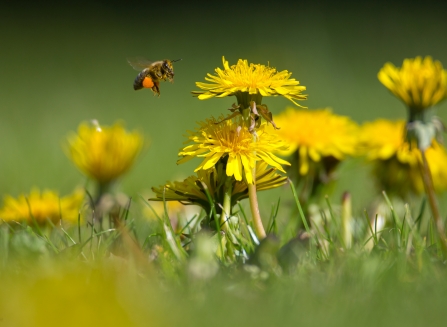Go anywhere in the temperate zones of the world and you’ll find dandelions. These hardy, sunshine yellow flowers beam triumphantly from spring onwards, growing in all kinds of grasslands from lawns to roadside verges; pastures to traditional meadows; not to mention out of pavement cracks and derelict land in towns and cities. Their distinctive seed ‘clocks’ bring back childhood memories of blowing their seeds and watching them float off in the breeze.
A fine and dandy flower
John Hawkins - Surrey Hills Photographu
Richard Burkmar
Despite being one of the most well-known flowers in the world, dandelions have a reputation for being a pest and a weed; a plant that should be removed at all cost. The negative perception we have of dandelions is truly undeserved, and seems to come from a combination of aristocratic one-upmanship and a great marketing campaign by weed killer companies. As far back as the 1500s, nothing showed off how rich you are like having a vast, manicured lawn free of plants and animal droppings, that you could pay people to manually weed for you. Only peasants allowed dandelions to grow around their homes. Flash forward hundreds of years and manicured lawns are still popular, while dandelions are not.
Most people can't afford gardeners or don't wish to spend time pulling out weeds by hand, so they use herbicides, adding chemicals harmful to both plants and animals to the environment. Dandelions are often front and centre on the labels of these herbicide bottles.

John Hawkins - Surrey Hills Photographu
Dandelions are brilliant for all sorts of reasons. All parts of the plant are edible and have been used across Europe and Asia for their medicinal properties for centuries. But even better, they are a useful species in our gardens and to native wildlife. Dandelions are among the first flowers to bloom in spring, offering a reliable source of food for our pollinators – bees, butterflies, moths, lacewings, beetles, hoverflies and more can all be seen dining among the yellow petals. After the insects have done their job of pollination, birds will eat dandelion seeds too.
As well as feeding our wildlife, dandelions are pioneer species, great at improving soil conditions for other plants. Dandelion roots grow thick and deep, loosening soil so that more air gets in, which helps with water drainage and preventing boggy lawns. Dandelions don't compete for nutrients with grass either, as grass roots are much shallower. In fact, when dandelions die, they add more nutrients to the top layers of soil, making the soil more fertile. As their roots rot away, they leave underground tunnels for worms and other microbes to travel through.
Richard Burkmar
So next time you’re weeding your garden, vegetable patch or allotment, consider leaving some dandelions for nature (and any you do weed, use to make dandelion and burdock pop). Think about the butterflies and bees emerging from hibernation, that haven’t eaten for months, and the good the dandelion will be doing for the worms in the soil. If you must remove any dandelions, do so by hand and certainly don’t use herbicides.

